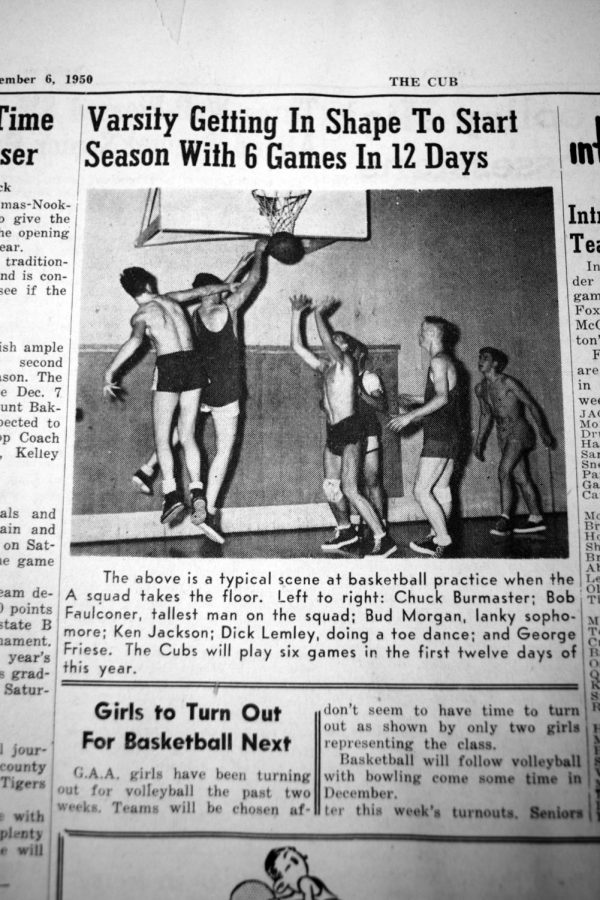A Glimpse of the Past- Stories Published in Former Editions of The Cub
November 9, 2022
Here we have compiled old stories from The Cub Newspaper, spanning across the many decades that we have been operating, to celebrate the 100th anniversary of The Cub. Journalism has been an important forum for cubs to document the life and times of students and staff. 100 years ago, students didn’t have the internet to tell eachother what was going on at school- so they used The Cub Newspaper to do just that. These are reminders that it is important to cherish student journalism, and to keep it alive for the coming years.
From the Tuesday, November 24th, 1931 issue of The Cub “Letters to the Editor”
Dear Editor, I would like to comment upon one ruling that has recently gone into effect at school. That is the rule of keeping the students out of the corridors (lower one in particular) during the lunch period.
On these cold, stormy and bad days, who wants to walk about half a block with no coat or hat on through the rain-or snow? When the students eat in the cafeteria they can’t get to their lockers unless they go out in the weather.
Teachers are continually speaking of not getting colds, but yet we have to run around in the rain, snow and sleet with no heavy clothes.
When I speak of this I know I am speaking in behalf of the student body. No one likes it. I think talking to the students would help them more than THIS poor method.
From the Wednesday, March 6th, 1946 issue of The Cub: “Fads and Fashions”
It’s a sure sign of spring when the girls step out in cotton wash dresses and light blouses, while the boys take off their sweaters and display colorful sports shirts.
Shirley Harrison looks sweet in her red trimmed, white peasant blouse.
For GAA dress ideas, look at Pat Serrurier’s white eyelet plaid cotton dress.
Bob Sanders has just the thing when he wears a beige and green plaid sport shirt with cords to school.
Blanche McKinney’s blue denim pinafore with imatation apron and shirt in red plaid is just the thing for school wear.
Elouise Small looks cool in her silk beige blouse.
That light blue, capped sleeve dress of Barbara Plummer’s is just the thing for an afternoon tea.
Yellow always looks handsome on a boy and even more so when Bob Ward displays his yellow sport shirt.
Jo Ann Kronick is glad for these sunny days as it gives her a chance to wear her white cotton dress.
“Tis a bit of Old Ireland,” that’s why Chet Long’s green plaid shirt is. Very handsome, indeed.
Matching a black sweater blouse with a red and black plaid skirt is just the thing for Colleen Evitt.
Gaye Knoppi looks neat and chic in her pink silk high necked blouse.
Floye Mood’s gray pin-striped dress certainly fits any occasion.
From the Wednesday September 27th, 1950 issue of The Cub: “Senior Sketches”
One of the best-known senior boys in SWHS is a cheerleader, Wilson Horne. Willie has attended high school here since he was a sophomore. His freshman year was spent at Lopez High School. Originally from Evansville, Indiana,
Willie reached the ripe old age of 18 on March 29th, 1950. He has two sisters, one brother, and no special girlfriend. Interesting, hmmmmmm? His favorite pastime is eating everything. Everything except hominy, that is. After May 1951, he plans to go fishing in Alaska, and then join the Air Corps. Willie’s favorite subject is choir, but he has no favorite teacher. After thinking very hard, he decided that women drivers are his pet peeve.
From Thursday October 2, 1952 issue of The Cub: “Pep Rally”
“Yea blue, yea white, yea team, fight, fight.” The annual homecoming pep rally will be held Thursday night, October 16, on the local field at 7:30. Students, faculty, and graduates are all invited.
The main event will be the burning of the Arlington dummy in the huge bonfire.
Yells and songs will be led by Barb Thurston, Nance Paulson, Shirlee Davidson, Jean Duvall, Shirley Howlett, Judy Coryell and Shirley Ziebell.
“Pep talks will be given by various students and we will all be booming with school spirit,” stated song and yell queens Shirley Howlett and Barb Thurston.
Last on the pep rally program there will be a gay serpentine which will be led around town.
The pep rally and serpentine is to arouse spirit for the homecoming game with Arlington. “Everyone come and have lots of fun,” the yell leaders urge.
From the November 25, 1981 Issue of the Cub: Fall Sports Wrap-Up
If you have seen a mean looking bald headed man in the halls you probably have figured out that the cub varsity football team reached their goal of four wins. After the team crushed Stanwood, head coach Irving Sigler shaved his head.
Freshman coach Mark Hester held up the tradition by shaving his much loved mustache after the Frosh downed the rival Burlington Tigers.
Although junior varsity coach Larry Brown did not shave his head, though his boys did just as well, going undefeated.
The only fall sport participants that will go to state are Renee Crawford, Jenny Swanson, Sarah Shanander and Kim Young. These two doubles teamsplaces one and two at the District tournament.
The volleyball team had a good year, and just missed making the playoffs. The cubs should be totally awesome next year, with many returning starters.
The Cross-Country team had its best season in many years, led by Senior Chris Ochs, and Junior Wendy Cargile.
From the December 18th, 1996 Issue of The Cub: Blood Drive Deemed A Success
On November 21st nearly 100 SWHS students donated blood. According to The Puget Blood Center, it was the largest turnout since 1987. For every pint of blood donated three patients can be helped. With the Cubs donations, close to 300 people will be helped.
Jeff Rhiner, Jamie Scott, and Amanda Mudler were the advisors and students in charge of organizing the blood drive. These people did an excellent job in their efforts and abilities to organize this event. The wrestling coaches allowed the use of the matt room.
Seventy percent of people require a blood transfusion in their lifetime. Last March, 78 students and teachers gave blood. Although some were too afraid to give blood because of the needles or for other reasons, those who did felt so great.
“I was a little out there after giving blood, but I am glad to have done a good deed,” replied Kris Greening after the blood giving effects wore off.
Out of 1060 students only 78 gave blood. That is not even 1/10 of the school’s population, as a total of 97 pints of blood.
Sophomore Stacy Cocke said she would have given blood, “But you have to be 16.” “The line to give blood was so long that I was there an hour anf forty-five inutes and still did not get a chance to give blood,” said Josh Hunter on one of the many reasons for not giving blood. Yet another reason for many students not donating was for athletic reasons. If you are participating in any sport it was advised you not donate because it takes a month to replenish that pint of blood, strenuous exercise is also not advised.
There was an exception good outcome from this and “It is for a good cause,” replies Sunny Hammontree on why dhr decided to give blood. The next blood drive will be held sometime in March.
From the December 1998 edition of The Cub: “Block Scheduling: Pros and Cons”
Staff and administration have been working toward next year’s move to block scheduling. In October the Principal of Lynden and several of his staff members came down and gave the SWHS staff a seminar on moving to the four period day.
Many steps have to be taken before next year and the implementation of block scheduling, however the change has people looking into the advantages and disadvantages of the proposed schedule.
English teacher Kay Hoffman pointed out that overall class time is lost in a four period day over the course of a year. “There were 90 classes per semester. Under the new schedule, classes will meet for 9 weeks for 80-90 minutes, which is 65-75 hours per semester.” Hoffman points out, “Will this improve education? Will this allow us to get into greater depth? How? This shortens each class by 5 weeks, (80 minute schedule), or 3 weeks (90 minute schedule).” Science teacher Brian Isakson had a different point of view. “I think students can really focus on the four courses they have that term. They can do a better job on those four classes than on six. Teachers can also do a better job with 85 students per semester rather than 150 per semester.
“Time doesn’t matter,” said visual communications teacher Steve McCart. “What matters is what you do with that time. I had 90 minute classes in college and I had 50 minute classes on basically the same subjects. I think the benefits of concentrating on a smaller group of students for the teachers and concentrating on a smaller load of classes for the student will be advantages that far outweigh the disadvantages.”



